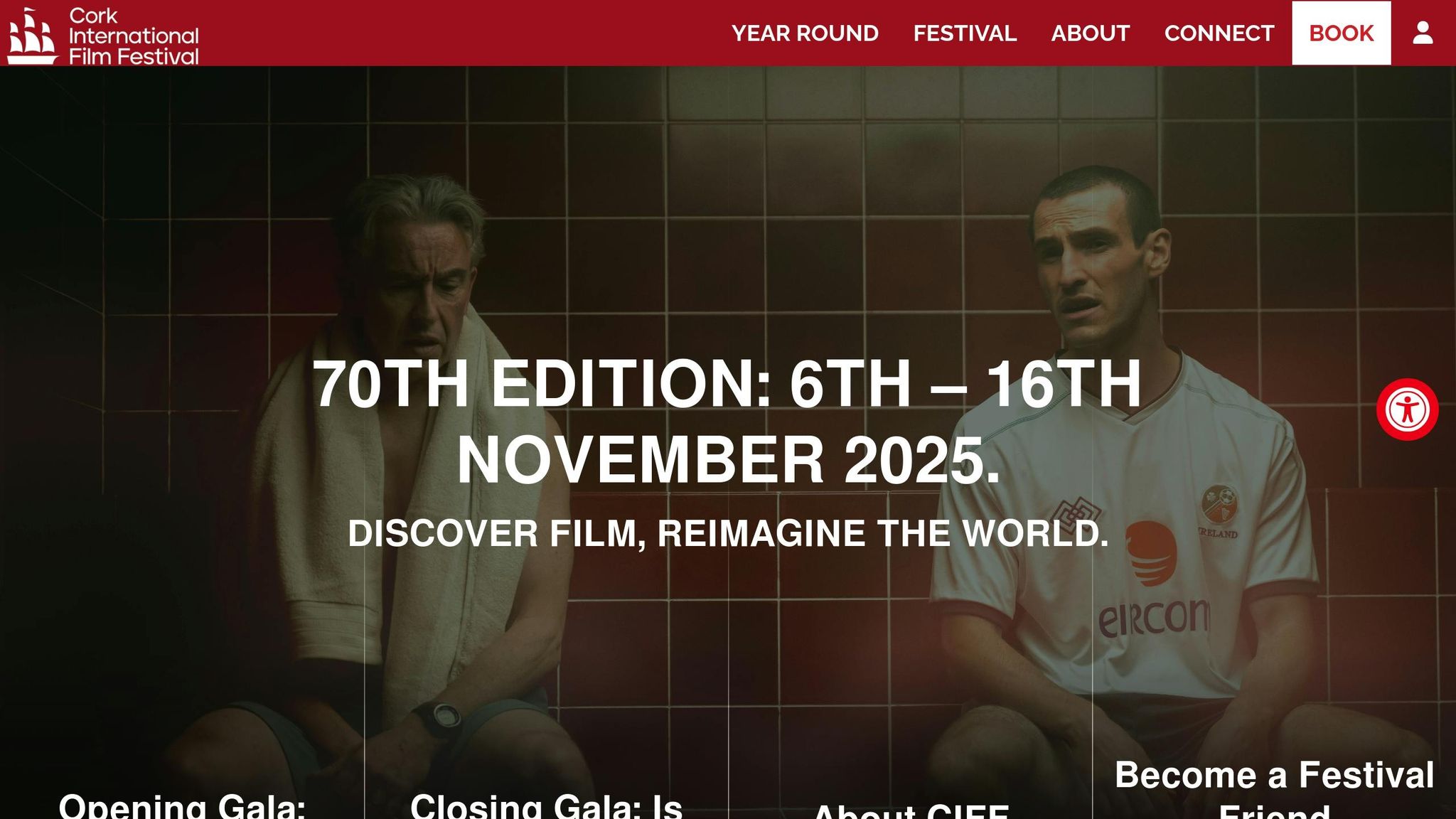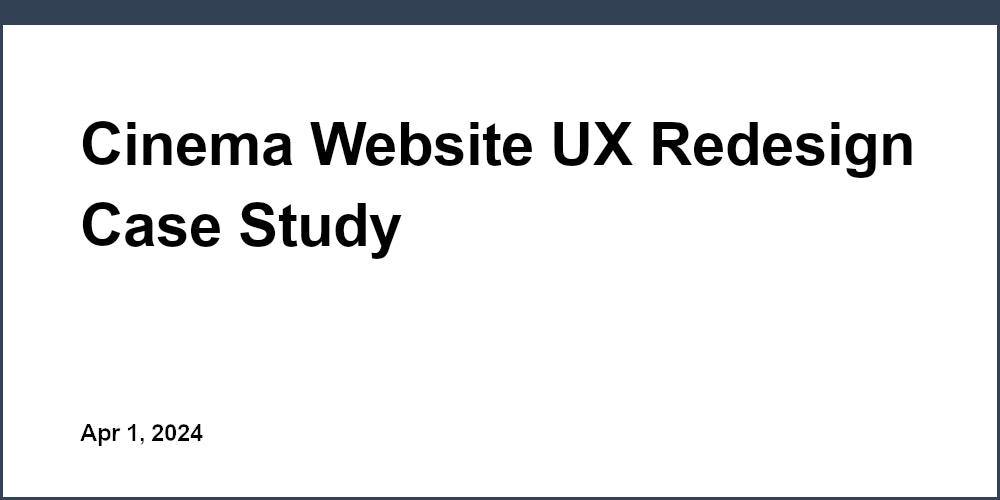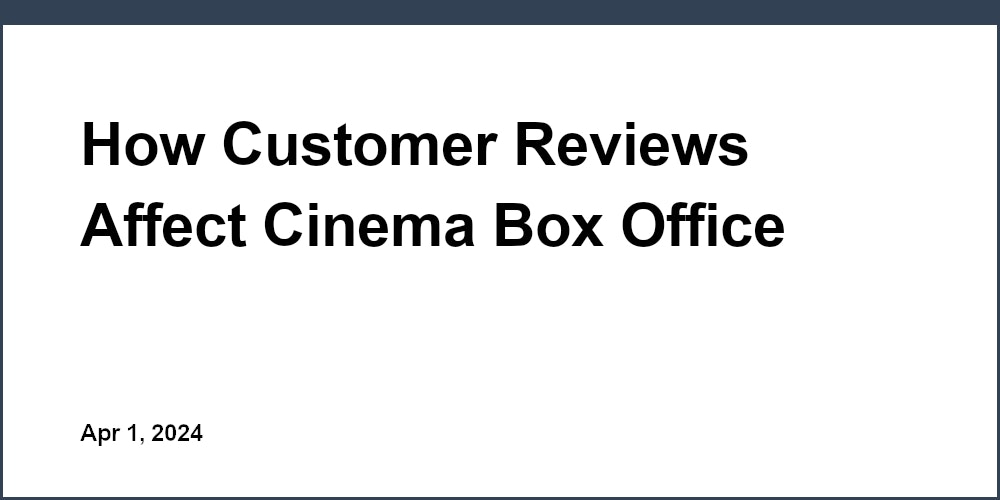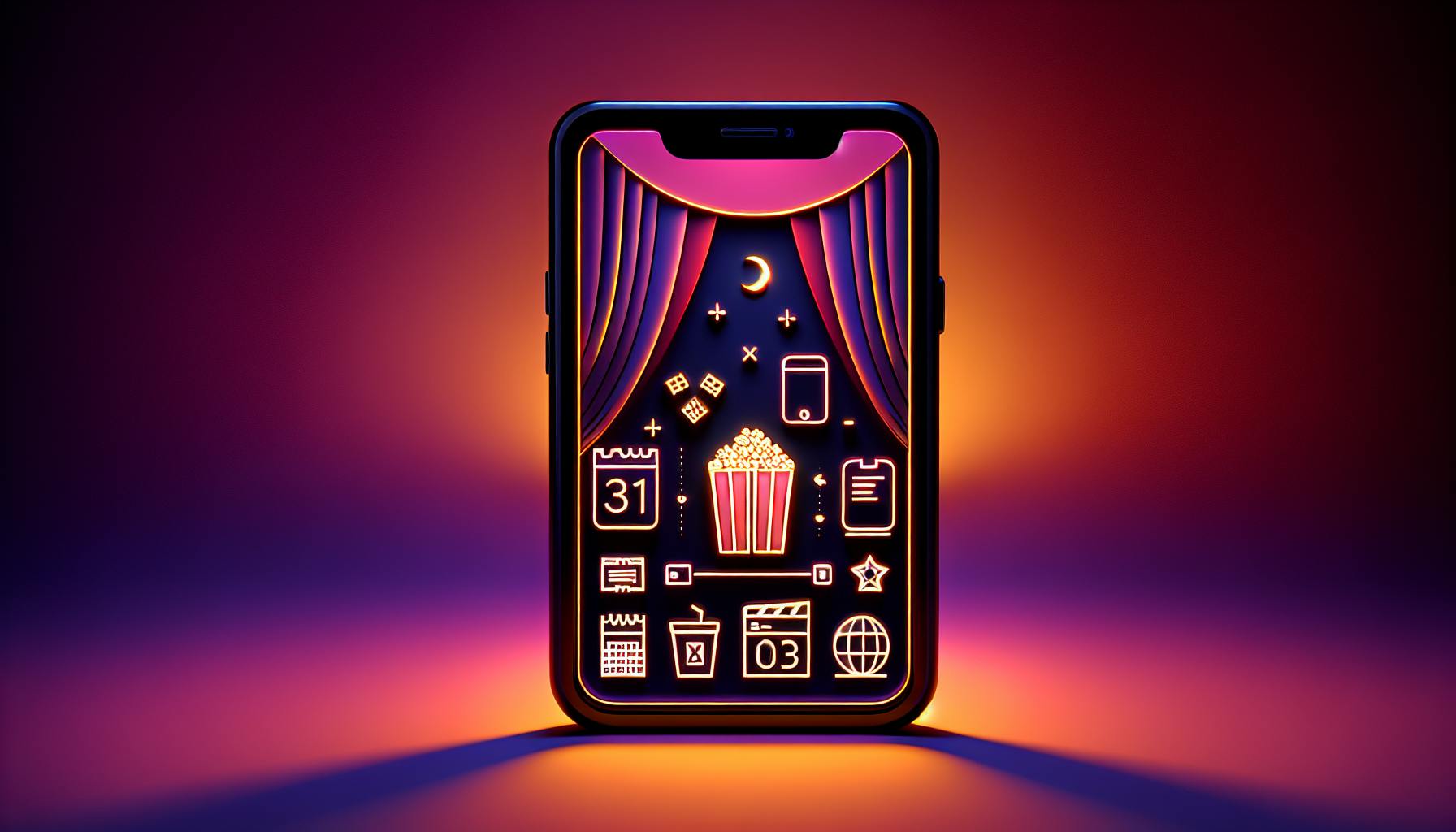Media partnerships are critical for film festivals to grow their audience, boost ticket sales, and build credibility. By collaborating with media outlets like radio stations, blogs, and newspapers, festivals can overcome challenges like low visibility, tight budgets, and competition from streaming platforms. These partnerships go beyond simple advertising, offering opportunities for content creation, targeted outreach, and measurable results.
Key takeaways:
- Festivals face issues like low attendance, limited budgets, and outdated marketing strategies.
- Media partnerships provide access to larger audiences, boost ticket sales, and enhance reputation.
- Examples include radio promotions, social media campaigns, and exclusive interviews.
The result? Festivals can attract more attendees, secure sponsorships, and remain relevant in a competitive market.
Cork International Film Festival 2020. Proud Principal Media Partner RTÉ

The Problem of Low Festival Visibility
Film festivals across the United States face an uphill battle in grabbing audience attention in today’s crowded entertainment world. Traditional marketing methods often fail to connect with film enthusiasts effectively.
Common Obstacles to Reaching More Audiences
One of the biggest hurdles film festivals face is competing with the convenience of streaming platforms and the shift in viewer habits. With films available on demand, many people prefer the comfort of watching at home rather than attending live events.
Another challenge is limited budgets. Many festivals operate on tight funding, which leaves little room for widespread advertising or promotional efforts.
Outdated marketing tactics and a fragmented media landscape further complicate outreach. Relying on ineffective strategies - such as poor audience research, weak branding, and underutilizing various marketing channels - prevents festivals from connecting with their target audiences.
Operational inefficiencies also drain resources. For instance, the Montclair Film Festival saw a significant improvement when it switched from paper ballots to digital voting. This change not only streamlined the process but also boosted audience participation by 30%.
"Votemo helped us successfully make the shift to electronic balloting. The backend of the product was user friendly and customer service assistance during setup made this transition so easy. Our audience appreciated the more sustainable option for voting and our staff appreciated not counting ballots until early morning on our busy days! Looking forward to continuing this relationship with Votemo and Montclair Film." - Jennifer Cambras, Director of Production and Special Projects, Montclair Film
Generational gaps add another layer of complexity. Traditional outreach methods often fail to resonate with younger audiences, as seen in the low attendance rate of just 18% among those under 25.
Together, these challenges weaken ticket sales and audience engagement, making it harder for festivals to thrive.
How Poor Visibility Hurts Ticket Sales and Engagement
These issues have a direct impact on the financial health and community presence of film festivals.
When attendance drops, ticket revenue takes a hit. This creates a ripple effect, making it harder to attract high-quality films, sponsors, and media attention. Without these elements, festivals struggle to generate excitement for future events or build a loyal following.
Low engagement also robs festivals of valuable opportunities to gather feedback and strengthen community ties.
Sponsors often hesitate to invest when festivals fail to demonstrate strong attendance and engagement metrics. Corporate partners typically prioritize measurable results, and without them, festivals risk losing critical funding.
A case in point is the Ibero-American Film Festival of Huelva, which faced similar challenges. Organizers realized that their traditional communication strategies weren’t connecting with younger audiences, prompting them to adopt a more dynamic approach.
"Festival organizers identified that their traditional communication framework was insufficient for engaging younger audiences, necessitating an innovative approach." - Angelo Puccia et al.
Modern audiences crave more than just films - they want immersive, interactive experiences. When festivals fail to highlight these unique offerings, they miss the chance to stand out from at-home viewing options.
The long-term survival of festivals also hangs in the balance. Consistently low attendance makes it difficult to secure venue partnerships, attract quality submissions, and maintain the community support necessary for ongoing success.
How Media Partnerships Solve Festival Problems
Media partnerships are a powerful way for film festivals to boost visibility and drive ticket sales without stretching their budgets. By tapping into established media channels, festivals can reach broader audiences and create meaningful buzz.
What Media Partnerships Include
Media partnerships go far beyond simple advertising. Festivals often trade assets like tickets, VIP passes, or booth space in exchange for media coverage. This approach secures valuable exposure - such as airtime, digital ads, and feature articles - without the need for a hefty financial investment.
The most effective partnerships span multiple media outlets. For instance:
- Radio stations: Offer on-air mentions, run contests, and even host live sessions.
- Digital platforms: Provide social media shoutouts, email campaigns, and website features.
- Local newspapers and magazines: Contribute print articles and online coverage to build trust and awareness.
Collaborative content creation is another key element. Festivals and media partners can team up to produce artist interviews, curated playlists, live session recordings, and engaging contests. These efforts naturally promote the festival while attracting the attention of interested audiences.
In today’s digital age, partnerships often incorporate streaming services and social media platforms. With 75% of fans citing social media as their go-to source for festival updates, platforms like Instagram, TikTok, and Facebook have become essential for increasing visibility.
How Both Sides Benefit from Media Partnerships
Media partnerships create a win-win situation. Festivals gain access to established audiences and trusted media platforms, while media outlets receive exclusive content that enhances their programming.
For festivals, the main goal is driving ticket sales. Successful partnerships focus on measurable outcomes, as highlighted by Ticket Fairy Promoter Blog:
"Make media partnerships sell tickets – not just create buzz."
- Ticket Fairy Promoter Blog
On the other hand, media outlets benefit from exclusive content like live broadcasts, artist interviews, and contest prizes, which keep their audiences engaged. Timing is critical - coordinating promotions around key moments, such as early-bird ticket launches or lineup announcements, ensures maximum impact.
Brand association is another major perk. Surveys show that 76% of festival-goers view sponsoring brands more favorably, and brand consideration among attendees jumps by 60% compared to those who don’t recall any partnerships. These benefits help festivals tackle challenges like limited exposure and declining ticket sales while strengthening the reputation of their media partners.
Real Examples of Effective Media Partnerships
Several festivals have demonstrated how strategic media partnerships can deliver impressive results. For example:
- Latitude Festival worked with Virgin Radio UK to promote lineup announcements.
- Austin City Limits collaborated with local radio stations to feature intimate artist recordings.
- Tomorrowland partnered with Belgian radio stations to broadcast live during ticket sales.
- A California indie festival reported over 500 discount code redemptions thanks to a radio partnership.
- Dublin’s Canalaphonic Music & Culture Festival teamed up with Radio NOVA for extensive on-air promotion.
- A Latin Music Festival in Los Angeles worked with radio stations to share Spotify playlists and host weekly "Festival Preview" segments.
These examples highlight the importance of creating partnerships with clear, trackable outcomes. Instead of relying on vague awareness campaigns, these collaborations focus on immediate ticket sales while building long-term audience engagement and trust. By doing so, festivals can address their core challenges and set the stage for sustained success.
Main Benefits of Media Partnerships for Festivals
Media partnerships provide festivals with measurable advantages that extend well beyond basic exposure. These collaborations create opportunities for growth and engagement that festival organizers can track and refine over time.
Reaching More Audiences
Partnering with media outlets opens doors to established audiences that festivals might otherwise miss. Whether it’s through local newspapers, radio stations, or online platforms, these partnerships help festivals expand their reach significantly.
The real strength lies in delivering targeted messages. For instance, social media is perfect for connecting with younger moviegoers, while arts publications resonate more with cultural enthusiasts. This tailored approach ensures marketing efforts hit the right notes with specific demographics, making every dollar count.
Cross-promotion takes this reach even further. Imagine a radio station highlighting a festival during morning drive time, following up with social media posts, and airing filmmaker interviews throughout the week. This repeated exposure builds familiarity and trust with potential attendees.
Media partnerships also allow festivals to expand geographically without breaking the budget. For example, a festival in Austin could collaborate with media outlets in Dallas to attract attendees from across Texas while maintaining a strong local presence. This strategy grows the audience base and drives ticket demand.
Increasing Ticket Sales
The combination of increased exposure and exclusive promotions often translates directly into ticket sales. Announcing early-bird tickets on the radio, sharing discount codes via email newsletters, or promoting limited-time offers on social media creates a sense of urgency that turns interest into action.
Timing is everything. Aligning media coverage with key moments - like lineup announcements or final ticket pushes - ensures maximum impact when audiences are most engaged. Festivals can track these efforts by monitoring website traffic spikes, social media activity, and ticket sales data. This information not only proves the effectiveness of media campaigns but also helps optimize future strategies.
These partnerships don’t just sell tickets - they also build a foundation of trust and credibility.
Building Brand Trust and Audience Engagement
When a festival is featured by trusted media outlets, it gains instant credibility. Coverage from respected local newspapers or well-known radio stations reassures potential attendees that the event is worth their time and money.
Media partnerships also open doors for storytelling that goes beyond the surface. Behind-the-scenes filmmaker interviews, features on how the festival impacts the community, and profiles of local talent help position the event as more than just entertainment - it becomes a meaningful part of the cultural landscape.
Interactive content like live Q&As, polls, and contests keeps audiences engaged and ensures the festival stays on their radar. Consistent media coverage throughout the year - sharing updates on programming, new initiatives, or community contributions - fosters lasting relationships and audience loyalty.
Digital tools amplify these benefits even further. Custom festival apps and integrated websites make it easy to distribute exclusive content, send targeted notifications, and track user engagement. Analytics from these platforms provide valuable insights into audience preferences, helping festivals and their media partners refine strategies for even greater impact. For example, solutions like Filmgrail offer real-time analytics and engagement tools that strengthen these collaborations.
sbb-itb-b1b0647
Best Methods for Creating Media Partnerships
Building effective media partnerships requires more than just sending out a few emails. The best collaborations are grounded in clear communication, mutual benefits, and measurable outcomes that both parties can evaluate and celebrate.
Setting Clear Goals and Agreements
Every successful partnership starts with shared objectives. Festivals need to define their goals - whether it's selling more tickets than the previous year, boosting social media engagement, or expanding their reach to new regions. These goals should align with what media partners can realistically deliver.
For instance, a local radio station might be perfect for reaching commuters aged 25–54, while a niche film blog could attract dedicated movie enthusiasts who attend multiple screenings. Knowing these strengths helps set realistic expectations and avoids misunderstandings.
It’s crucial to outline specific deliverables and deadlines. Replace vague promises with clear commitments, such as a set number of social media posts or live updates. This approach keeps everyone on the same page and ensures both sides know what success looks like.
Don’t overlook payment structures or value exchanges. While some partnerships involve direct payments, others might rely on perks like in-kind benefits or exclusive promotions. Regular check-ins, whether through weekly calls or email updates, help address any issues early and keep the collaboration on track. Establishing these benchmarks ensures smooth communication and effective local media partnerships.
Working with Local Media Outlets
Partnering with local media outlets can be a game-changer. These outlets offer trusted connections within their communities and provide a direct link to potential festival attendees. Local audiences are more likely to show up in person rather than just engaging online, making these partnerships particularly valuable.
To build strong relationships, research each outlet’s audience and tone. For example, a morning radio show focused on entertainment news might respond to a light, energetic pitch, while an arts magazine known for in-depth features would appreciate a more thoughtful, detailed approach. Tailoring your pitch to match their style increases your chances of forming a meaningful partnership.
These relationships don’t have to end when the festival does. Many successful festivals maintain year-round connections with local media by sharing filmmaker stories, industry updates, or positive community impacts. This ongoing presence keeps the festival in the public eye and strengthens annual promotional efforts.
Investing time in these relationships pays off. Local media partners often become enthusiastic advocates for the festival, amplifying its reach and creating a solid foundation for future collaborations.
Tracking Partnership Results
Measuring the success of a media partnership involves looking at both short-term wins and long-term impact. Interestingly, nearly 40% of event organizers struggle to demonstrate ROI because they wait until after the event to start tracking results.
For in-person events, common metrics include attendance (67%), revenue (56%), attendee engagement (54%), and brand awareness (51%). Post-event analysis can reveal even more, such as attendee satisfaction through Net Promoter Scores, media partner feedback, and commitments to future collaborations. Over half of businesses report that partnerships contribute more than 20% of their total revenue, highlighting the importance of tracking these metrics.
| Tracking Phase | Key Metrics | Why It Matters |
|---|---|---|
| Pre-Event | Website traffic, social media mentions, email sign-ups | Shows early interest and engagement |
| During Event | Ticket sales, app usage, real-time feedback | Tracks immediate results and participation |
| Post-Event | NPS scores, partner satisfaction, future commitments | Evaluates long-term value and relationship strength |
By integrating data from registration platforms, social media, and partner reports, festivals can get a full picture of how well their partnerships performed.
"You can't improve what you don't measure." - Ticket Fairy Promoter Blog
Regular reporting is essential. Monthly updates leading up to the festival and thorough post-event reviews help both sides understand what worked and what could be adjusted. This kind of transparency often leads to stronger relationships, with media partners becoming more invested in future collaborations.
Tools like Filmgrail make tracking easier by providing actionable insights. These insights enable festivals and their media partners to make smarter, data-driven decisions, improving outcomes throughout the partnership.
Using Technology to Improve Media Partnerships
Technology plays a crucial role in making media partnerships more efficient and results-driven. The right tools simplify communication, automate promotional efforts, and deliver detailed insights, helping both festivals and media partners achieve their goals more effectively.
Custom Apps and Websites for Festivals
Festival-specific apps and websites act as central hubs where media partners can easily find engaging content. These platforms are designed to grab audience attention and boost ticket sales.
Features like auto-playing trailers immediately capture a visitor's interest. When someone lands on a festival page, these trailers draw them in, increasing the chances they’ll explore further or purchase tickets. This feature becomes even more impactful when media partners share festival links on their platforms, creating an instant connection with potential attendees.
Another valuable feature is video stories, which allow festivals to showcase behind-the-scenes moments, filmmaker interviews, or event highlights. Media partners can easily embed these stories into their coverage, whether it’s a social media post or a newsletter. These bite-sized videos are versatile and work across various formats, making them a powerful tool for engagement.
Platforms like Filmgrail take things a step further by incorporating local reviews and ratings from audiences in the same city. This localized approach enables media partners to create content that feels more relevant to their communities, enhancing the value of their coverage.
To complement these tools, automation adds another layer of efficiency to promotional efforts.
Automated Marketing and Analytics Tools
Automation simplifies media coordination and ensures consistent messaging. Since the pandemic, 78% of event planners have increased their use of event technology to elevate their marketing efforts.
Email marketing automation allows festivals to tailor their communications to different media partners. For instance, entertainment bloggers may receive distinct content packages compared to local radio stations, ensuring that each partner gets materials suited to their audience and format.
Social media management tools help organize and schedule posts across various platforms, ensuring content reaches audiences at the right times without overwhelming any single channel. These tools also track hashtags and keywords, providing insights into which content resonates most with specific audiences.
The ability to integrate marketing platforms has become essential for smooth operations. For example, 62% of marketers now use built-in marketing or CRM software for campaign reporting. Tools like Zapier automate data sharing between systems, updating contact records and triggering follow-ups when media partners share festival content or when their audiences engage with promotions.
Analytics integration is another game-changer, offering real-time insights into which media partnerships drive the most traffic and conversions. Instead of waiting until the festival ends to assess performance, organizers can adjust their strategies mid-campaign using data from various media channels.
A great example of this approach comes from Bizzabo’s Event Experience OS in July 2023. Their platform used personalized registration flows, advanced promo codes, and UTM tracking to boost revenue. Email segmentation improved open rates, while tracking codes and Google Analytics integrations provided a detailed look at campaign performance. These insights allowed organizers to measure success and demonstrate ROI to stakeholders.
With these tools in place, festivals can also focus on building loyalty through better audience experiences.
Building Loyalty Through Better Experiences
Technology-driven loyalty programs enhance engagement and reward interactions, creating lasting connections between festivals, their audiences, and media partners. Platforms like Filmgrail leverage features such as personalized push notifications to keep audiences engaged. For example, users receive notifications about movies they’ve added to their watchlists, making the communication feel relevant and welcome.
Loyalty point systems offer another way to deepen engagement. Attendees can earn points for interacting with media partner content - whether that’s reading articles, sharing posts, or attending events sponsored by partners. This benefits both sides: media partners see increased engagement, while festivals strengthen relationships with their audience. By embedding loyalty features into festival platforms, media partners enjoy sustained audience interaction, enhancing the value of their collaboration.
The global event management software market underscores the growing importance of technology in creating engaging experiences. It’s projected to hit $18.4 billion by 2029, growing at an annual rate of 12.9%. This trend highlights the competitive edge festivals can gain by investing in comprehensive tech solutions.
Data analysis tools also play a key role in understanding audience preferences. For example, ChatGPT’s data analysis features (available in the paid version) can process attendee data exported into CSV format, adding industry tags and enriching insights about the audience. This deeper understanding helps festivals and media partners craft more targeted and effective content strategies.
Conclusion: Making the Most of Media Partnerships
Media partnerships can be a game-changer for festivals, offering a way to grow, engage audiences, and strengthen community connections. For festivals struggling to gain visibility, these collaborations provide a reliable route to boost ticket sales, foster deeper audience connections, and establish long-term brand recognition.
The impact is undeniable. Take the International Film Festival of Manhattan (IFFM) as an example - its year-round media strategy has led to broader reach and stronger ties within the industry. This kind of transformation highlights how modern technology can further enhance festival promotions, making them more efficient and impactful.
Technology plays a pivotal role in amplifying these partnerships. Features like auto-playing trailers, personalized push notifications, and local audience reviews on custom festival platforms create dynamic experiences that media partners can easily share. Automated marketing tools and real-time analytics also help track which collaborations generate the most traffic and conversions, making it easier to measure success.
The key to thriving media partnerships lies in collaboration and clear communication. By setting clear goals, fostering transparency, and prioritizing mutual value, festivals can build trust that lasts beyond a single event. This approach transforms media partners into advocates who bring long-term benefits, reshaping how festivals connect with their audiences.
Festivals today are increasingly adopting year-round media collaborations to tackle visibility challenges. Sharing resources, cross-promotion, and ongoing audience engagement ensure that these events remain relevant beyond their usual timeframes. Those who embrace this model are setting themselves up for steady growth and a stronger connection with their communities.
FAQs
How can media partnerships help festivals stand out and attract younger audiences?
Media partnerships are a game-changer for festivals looking to connect with younger, tech-savvy audiences. By teaming up with digital platforms and social media channels, festivals can produce engaging content such as live streams, interactive videos, and AR experiences. These formats resonate with younger demographics while extending the festival’s reach far beyond those attending in person. It’s not just about the event itself - it’s about building a sense of community that lives on well after the last performance.
Platforms like TikTok, YouTube, and Instagram are where these audiences spend a significant chunk of their time. Media collaborations on these platforms can amplify a festival’s visibility, sparking higher engagement and, ultimately, driving ticket sales. The result? A festival that feels more accessible, exciting, and relevant to a broader audience.
How can festivals measure the impact of media partnerships on ticket sales and audience engagement?
To gauge how media partnerships are performing, festivals can focus on key metrics like ticket sales trends and audience engagement data. Ticket sales can show how these partnerships are affecting revenue, while engagement stats - such as likes, comments, shares, and other social media interactions - offer a glimpse into how much the audience is connecting with the content.
For a deeper dive, you can calculate engagement rates by dividing the total number of engagement actions by either your follower count or total reach. Using advanced analytics tools can take this a step further, helping uncover patterns, predict audience behavior, and monitor campaign performance in real time. These insights give a clear view of how well the partnership is working.
How can festivals build and maintain media partnerships to stay visible and connected with their community year-round?
Festivals can strengthen media partnerships by cultivating ongoing relationships with local media outlets, influencers, and community groups. This might involve working together on social media campaigns throughout the year, producing engaging content like behind-the-scenes videos or interviews, or organizing smaller community-focused events outside of the main festival season.
By staying connected with audiences through these collaborations, festivals can maintain visibility, deepen ties within the community, and generate buzz for upcoming events. A consistent, year-round strategy helps keep the festival relevant and ensures it remains on people's radar, even during the off-season.


